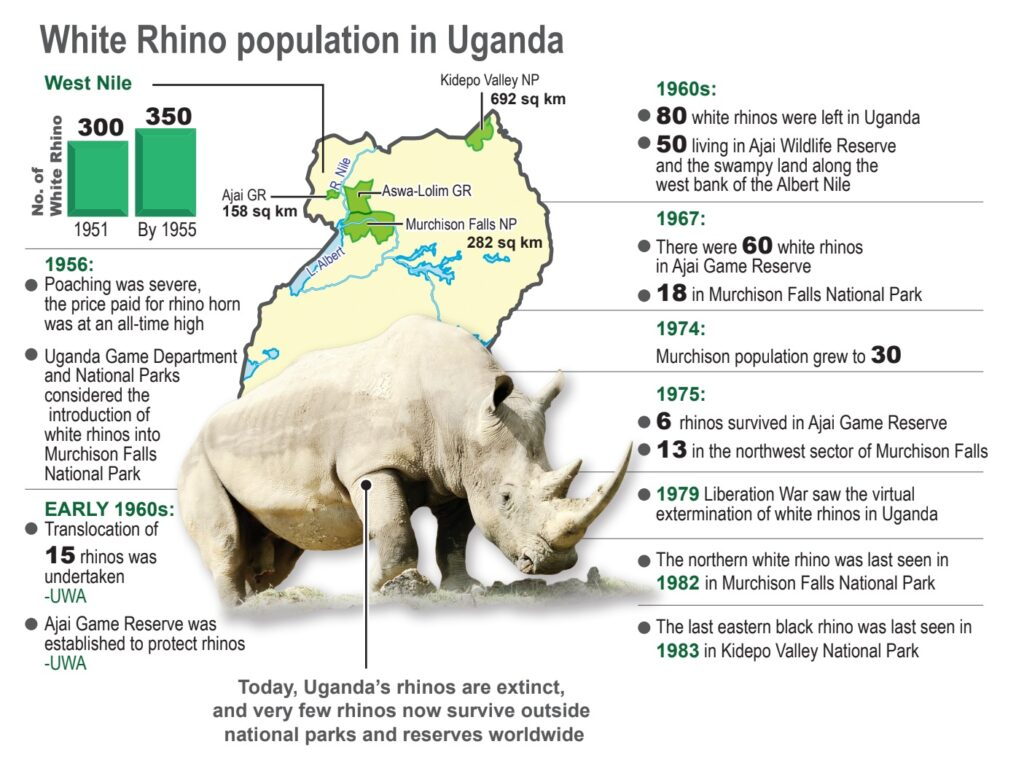Every day, Ugandans move closer to the moment when the southern white rhinos will be re-introduced into the wild. But the northern white rhinos, which previously occupied Uganda’s protected areas, are far from coming back home, writes Gerald Tenywa.
The name of the village is Rhino Camp in Madi Okollo in West Nile. As the name suggests, rhinos used to roam the village, and tourists used to camp there to see them as they grazed along the River Nile. Rhino camp was hit hard, as the prehistoric-looking animals were not spared by armed poachers that were all over the place in the 1970s and mid-1980s. The village lost its shine with the extinction of the northern white rhinos. The Rhino camp without rhinos for four decades kept on reminding Ugandans what they had lost.
The northern white rhinos were revered by the local people, according to Louis Onzima, a retired wildlife conservationist with a career spanning 33 years.
Onzima, in active service under the Uganda Wildlife Authority (UWA), worked in Ajai Wildlife Reserve, Murchison Falls National Park and Kidepo National Park. He still remembers his encounters with the local people at Rhino Camp, which is probably the only village with an English name.
“At first, people respected the rhinos,” says Onzima, adding that there was a tribal chief who revered the rhinos because they symbolise strength and resilience. “When the animals disappeared through poaching, the local people felt the reserve was useless.”
Onzima was several decades too late not to witness the visit by former US President Theodore Roosevelt, who walked the plains of Rhino Camp in 2010. Roosevelt hunted down some of the northern white rhinos.
The rhinos are the second biggest animals after the elephants on the planet. The female rhinos weigh about two tonnes; the males weigh up to three and a half tonnes, according to Flora and Fauna International.
As the northern white rhinos declined, poachers also drove the eastern black rhino species, which was previously resident in Kidepo, into extinction. The two species, the northern white rhinos and the eastern black rhinos, were driven into extinction at about the same time.
The disappearance of the northern white rhinos was as dramatic as their failure to return to Uganda.
In the last days, the Uganda National Parks, which was part of the colonial setup department, moved the few remaining northern white rhinos from Ajai down to Murchison Falls National Park. Murchison was better protected than Ajai at that time. However, poachers followed them and brought the lives of the northern white rhinos to an end, according to Onzima.
Two decades ago, the Garamba Game Reserve in neighbouring DR Congo lost its entire population of northern white rhinos after bandits and self-styled rebels set up camps and bases in the pristine environment. This was the last population of northern white rhinos after ranging states, including South Sudan and the Central African Republic, had lost their populations.
On the other side, countries including Uganda gave the northern white rhinos as gifts to some countries in Europe, including the Czech Republic.
As the population of the northern white rhinos declined in the wild, the Czech Republic moved them to Kenya, which was not a range state for the northern white rhinos. The population of northern white rhinos kept on declining until only two females were left at Ol Pejeta, a conservancy in neighbouring Kenya.
Earlier efforts to save northern white rhinos
 As far back as a century ago, the declining population of the northern white rhinos had caused a big concern among conservationists.
As far back as a century ago, the declining population of the northern white rhinos had caused a big concern among conservationists.
In 1924, an article in the bulletin of the Zoological Society of New York drew attention to the danger of extinction of the Northern White Rhinos, going the same way as had the Southern White Rhinos (only 20 to 50 individuals left in the wild worldwide at the turn of the century). Action was immediately taken in Uganda to preserve the country’s population, according to a press statement released by the Uganda Wildlife Authority (UWA).
A census carried out revealed about 150 individuals, mainly in the area along the left bank of the Albert Nile, especially near swamps and marshy areas; this was the most eastern extent of the historical range of the Northern White Rhinos.
“Sanctuaries were designated in 1938 to assist in protecting the white rhinos,” stated UWA in part. “These included the 170-square-mile Mt Kei Forest Reserve with 12 individuals and the 80-square-mile Mt Otze Forest Reserve, but the individuals moved to South Sudan.”
In 1951 the total White Rhino population of the West Nile District was estimated to have risen to around 300 individuals and to about 350 by 1955. In 1956, the price paid for rhino horn was at an all-time high, and poaching was severe. The Uganda Game Department and National Parks began considering the introduction of white rhinos into Murchison Falls National Park, and in the early 1960s, translocation of 15 individuals was successfully undertaken, according to UWA. By this time, there were only 80 white rhinos left in Uganda, with 50 individuals living in parts of Ajai Wildlife Reserve and the swampy land along the west bank of the Albert Nile, with the 158 sq km Ajai Game Reserve established to protect the rhinos, according to UWA.
In 1967, there were 60 white rhinos in Ajai Game Reserve and 18 in Murchison Falls National Park. The Murchison population grew to 30 by 1974. However, by 1975 only 6 rhinos survived in Ajai Game Reserve and 13 in the northwest sector of Murchison Falls National Park. The 1979 Liberation War saw the virtual extermination of white rhinos in Uganda. The northern white rhino was last seen in 1982 in Murchison Falls National Park, while the last eastern black rhino was last seen in 1983 in Kidepo Valley National Park. Today, Uganda’s rhinos are extinct, and very few rhinos now survive outside national parks and reserves worldwide.
UWA, which was formed after the merger of the Uganda National Parks and the then Game Department, teamed up with the Rhino Fund Uganda and started a programme to reintroduce rhinos back to Uganda.
This is being done under a three-phase approach of awareness creation, breeding programme and release to former habitats or reintroduction. So far, it is the introduction of the white southern rhinos, which have caught fire.
The chances of returning rhinos to Uganda have never been brighter than now. However, Ugandans will have to wait longer to have the northern white rhinos in the wildlife reserves.
“We have the potential to bring back the rhinos, as long as Uganda works with other governments in Kenya, South Africa, the US and global conservation bodies,” says Richard Muhabwe, the Chief Warden for Kidepo Conservation Area.
Dr. Robert Aruho, who is a veterinarian and conservationist, describes the southern white rhinos as the lowest hanging fruit for Uganda to repopulate the wild with rhinos. He says the southern white rhinos are closely related to the northern white rhinos.
“It is unrealistic to keep on hugging the northern white rhinos. We are remaining with only two female northern white rhinos globally; they are very old and cannot return to the wild. The long journey is to use embryos from them. The only way to have rhinos returning to Uganda is to go for a substitute, which is the southern white rhino,” he says, adding that the southern white rhinos are viable and available.



